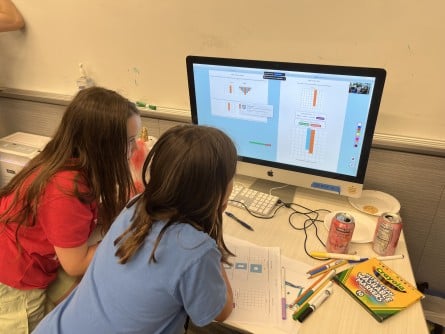In a world where artificial intelligence systems often exude a confidence that can mislead even the most knowledgeable adults, a new educational tool is empowering children to recognize and outsmart AI’s limitations. Developed by researchers at the University of Washington, the game AI Puzzlers challenges kids to solve reasoning puzzles that AI systems typically struggle with, demonstrating an area where human intuition still reigns supreme.
The game, which was presented at the Interaction Design and Children 2025 conference in Reykjavik, Iceland, allows children to tackle ‘ARC’ puzzles—short for Abstraction and Reasoning Corpus—by completing patterns of colored blocks. After solving the puzzles themselves, the children can ask AI chatbots to attempt the same puzzles and explain their solutions, which they often fail to do accurately. This interactive experience not only highlights the current shortcomings of AI but also encourages critical thinking among young users.
Understanding the Game and Its Impact
AI Puzzlers was tested with two groups of children, who learned to critically evaluate AI responses and even guide the systems toward better solutions. Lead author Aayushi Dangol, a doctoral student in human-centered design and engineering at UW, explained the universal appeal of these puzzles: “Kids naturally loved ARC puzzles and they’re not specific to any language or culture.” Because the puzzles rely solely on visual pattern recognition, even children who cannot yet read can engage with them, gaining satisfaction from solving puzzles that AI struggles with.
ARC puzzles, developed in 2019, are designed to be challenging for computers but straightforward for humans, as they require the ability to abstract patterns from limited examples. While AI models have improved, they still lag behind human capabilities in this area. AI Puzzlers includes 12 ARC puzzles, allowing children to compare their solutions with those generated by various AI chatbots. An “Ask AI to Explain” feature provides a textual explanation of the AI’s attempt, often revealing inaccuracies even when the AI arrives at the correct solution.
Insights from Testing and Co-Design
The researchers conducted tests at the UW College of Engineering’s Discovery Days with over 100 children from grades 3 to 8 and led sessions with KidsTeam UW, a collaborative design project involving children. Through these sessions, children not only identified errors in AI solutions but also provided valuable feedback that led to the development of an “Assist Mode.” This feature allows children to guide AI systems more effectively, demonstrating the creative problem-solving skills of young minds.
Jason Yip, a UW associate professor in the Information School and KidsTeam director, noted the importance of this collaborative approach: “The kids in KidsTeam are used to giving advice on how to make a piece of technology better.” The Assist Mode emerged from discussions with children about enhancing AI’s problem-solving abilities, underscoring the value of incorporating young perspectives in technology design.
The Broader Implications of AI Puzzlers
The ability of children to recognize the differences between human and AI thinking is a significant outcome of this research. As one child insightfully remarked,
“This is the internet’s mind. It’s trying to solve it based only on the internet, but the human brain is creative.”
Such observations highlight the potential for educational tools like AI Puzzlers to foster a deeper understanding of AI among young users.
Julie Kientz, a UW professor and chair in human-centered design and engineering, emphasized the importance of empowering children to form their own opinions about AI: “Kids are smart and capable. We need to give them opportunities to make up their own minds about what AI is and isn’t.” This approach not only cultivates critical thinking but also positions children as informed participants in the evolving landscape of AI technology.
Supported by funding from the National Science Foundation, the Institute of Education Sciences, and the Jacobs Foundation’s CERES Network, this research represents a significant step in integrating AI education into early learning. As AI continues to evolve, tools like AI Puzzlers could play a crucial role in preparing future generations to navigate and shape the technological world.
For more information on this groundbreaking project, contact Aayushi Dangol at [email protected], Jason Yip at [email protected], and Julie Kientz at [email protected].
